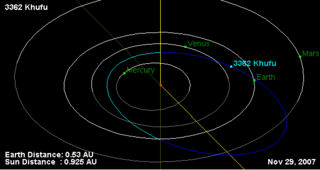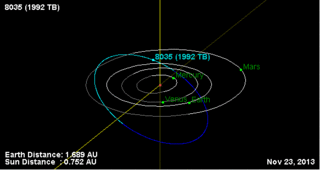Related Research Articles

1862 Apollo is a stony asteroid, approximately 1.5 kilometers in diameter, classified as a near-Earth object (NEO). It was discovered by German astronomer Karl Reinmuth at Heidelberg Observatory on 24 April 1932, but lost and not recovered until 1973.
(179806) 2002 TD66 (also written 2002 TD66) is a sub-kilometer asteroid, classified as near-Earth object of the Apollo group. It was discovered on 5 October 2002, by the LINEAR project at Lincoln Laboratory's ETS in Socorro, New Mexico. It was announced on 7 October 2002 and appeared later that day on the JPL current risk page.
4034 Vishnu is a rare-type asteroid classified as near-Earth object and potentially hazardous asteroid of the Apollo group, approximately 420 meters in diameter. It was discovered on 2 August 1986, by American astronomer Eleanor Helin at Palomar Observatory in California, United States. It is named after the Hindu deity Vishnu.

3362 Khufu is a near-Earth asteroid. It was discovered by R. Scott Dunbar and Maria A. Barucci at the Palomar Observatory in San Diego County, California, on 30 August 1984. Its provisional designation was 1984 QA. It is named after Khufu, an ancient Egyptian pharaoh. Khufu was the 4th Aten asteroid to be numbered.
6063 Jason is an Apollo asteroid discovered on 27 May 1984, by Carolyn and Eugene Shoemaker at Palomar. Its highly eccentric orbit crosses the orbits of Mars, Earth, and Venus. From 1800 to 2200 it approached a planet within 30 Gm 69 times: Mercury 11, Venus 27, Earth 18, and Mars 13 times.

(31669) 1999 JT6 is an Earth-crossing asteroid belonging to the Apollo family of asteroids which also crosses the orbit of Mars. 1999 JT6 is the asteroid's temporary discovery name. It has now been assigned a permanent number from the Minor Planet Center (31669) indicating that its orbit has been confirmed, but has not (at least so far) been assigned a name. Only a small fraction of asteroids have been named.

(276033) 2002 AJ129, provisional designation 2002 AJ129, is a Mercury-crossing asteroid. It has the ninth-smallest perihelion of all numbered asteroids, after asteroids such as 2000 BD19, 2004 UL, and 2008 XM. It makes close approaches to all of the inner planets and asteroid 4 Vesta. The asteroid is estimated to be between 0.5–1.2 kilometers (0.3–0.7 mi) across. In January 2018 there was much media hype about this asteroid being classified as a potentially hazardous asteroid, although there is no known threat of an impact for hundreds if not thousands of years. The media has compared the size of the asteroid to the Burj Khalifa in Dubai.
(101869) 1999 MM is a sub-kilometer asteroid on an eccentric orbit, classified as a near-Earth object and potentially hazardous asteroid of the Apollo group. It was discovered on 20 June 1999, by the Lowell Observatory Near-Earth-Object Search (LONEOS) at its U.S. Anderson Mesa Station in Flagstaff, Arizona. The first observation was made by Catalina Sky Survey just 8 days before its official discovery.
2012 KT42 is an Apollo near-Earth asteroid first observed by astronomer Alex R. Gibbs of the Mount Lemmon Survey with a 1.5-meter reflecting telescope on 28 May 2012.
(85640) 1998 OX4 (provisional designation 1998 OX4) is a sub-kilometer asteroid, classified as near-Earth object and potentially hazardous asteroid of the Apollo group.

(8035) 1992 TB is an Apollo asteroid, a type of Near-Earth Object. It is also a Venus-crosser and a Mars-crosser, although it doesn't make close approaches to Mars.

2005 HC4 is the asteroid with the smallest known perihelion of any known object orbiting the Sun (except sungrazing comets). Its extreme orbital eccentricity brings it to within 0.071 AU of the Sun (23% of Mercury's perihelion) and takes it as far as 3.562 AU from the Sun (well beyond the orbit of Mars). Due to its very small perihelion and comparably large aphelion, 2005 HC4 achieves the fastest speed of any known asteroid bound to the Solar System with a velocity of 157 km/s (565,000 km/h; 351,000 mi/h) at perihelion (there are comets, however, which obtain much higher speeds).
(374158) 2004 UL is a sub-kilometer asteroid on an outstandingly eccentric orbit, classified as near-Earth object and potentially hazardous asteroid of the Apollo group. The object is known for having the second-smallest perihelion of any known asteroid, after (137924) 2000 BD19.
(386454) 2008 XM is a highly eccentric, sub-kilometer-sized asteroid, with one of the smallest known perihelions among all minor planets. It is classified as near-Earth object of the Apollo group and was discovered on 2 December 2008, by the LINEAR program at Lincoln Laboratory's Experimental Test Site in Socorro, New Mexico, United States.

(523972) 1999 CW8, provisional designation 1999 CW8, is a bright carbonaceous asteroid and sub-kilometer near-Earth object of the Apollo group, first observed on 12 February 1999, by astronomers of the Lincoln Near Earth Asteroid Research program at Lincoln Laboratory ETS in New Mexico, United States.
(456938) 2007 YV56, provisional designation 2007 YV56, is a sub-kilometer asteroid on an eccentric orbit, classified as a near-Earth object and potentially hazardous asteroid of the Apollo group, approximately 190–360 meters (620–1,200 ft) in diameter. It was discovered on 31 December 2007, by astronomers of the Catalina Sky Survey conducted at the Catalina Station in Arizona, United States.

2018 CY2 is an asteroid, classified as a near-Earth object of the Apollo group, with an estimated diameter of 59–190 metres (190–620 ft). It was first observed on 9 February 2018, by astronomers of the Catalina Sky Survey at Mount Lemmon Observatory, Arizona, during its close approach to Earth.

2018 CC is a micro-asteroid, classified as a near-Earth object of the Apollo group, approximately 20 meters (70 ft) in diameter. Its official first observation was made by the Catalina Sky Survey at Mount Lemmon Observatory, Arizona, United States, on 4 February 2018. Two days later, the asteroid crossed the orbit of the Moon and made a very close approach to Earth.
(85182) 1991 AQ is a stony asteroid on a highly eccentric orbit, classified as near-Earth object and potentially hazardous asteroid of the Apollo group, approximately 1.1 kilometers in diameter. It was discovered on 14 January 1991, by American astronomer Eleanor Helin at the Palomar Observatory in California. Based on its brightness variation of 0.69 magnitude, this Q-type asteroid is likely elongated. It belongs to the small group of potentially hazardous asteroids larger than one kilometer.

2020 LD is an Apollo near-Earth asteroid roughly 140 meters in diameter. It was discovered on 7 June 2020 when the asteroid was about 0.03 AU from Earth and had a solar elongation of 154 degrees. The glare of the Sun had masked the approach of the asteroid since November 2019. The asteroid passed closest approach to Earth on 5 June 2020 at a distance of 0.002 AU. The close approach distance is now known with an accuracy of roughly ± 1000 km. This is the largest asteroid to pass closer than the Moon this year and possibly the largest since (308635) 2005 YU55 in November 2011. The asteroid makes close approaches to Mercury, Venus, Earth, and Mars. It will be brighter than apparent magnitude 24 until 18 July 2020.
References
- 1 2 3 4 "JPL Small-Body Database Browser: (2002 LY45); last obs (arc=4718 days)". Jet Propulsion Laboratory. 15 May 2013. Retrieved 7 April 2016.
- ↑ "NEODyS (89958) 2002 LY45". Near Earth Objects – Dynamic Site. Retrieved 12 March 2014.